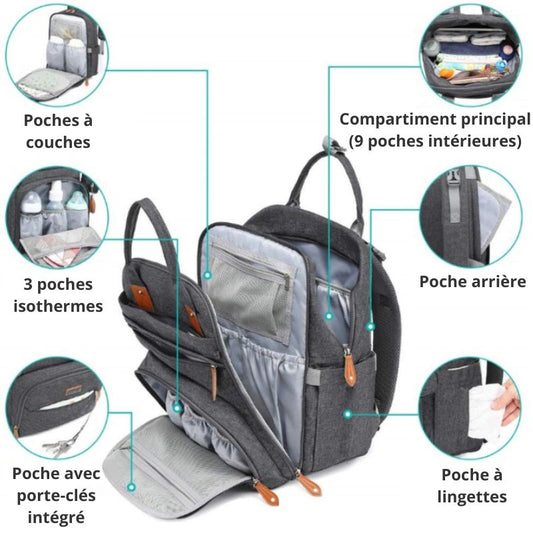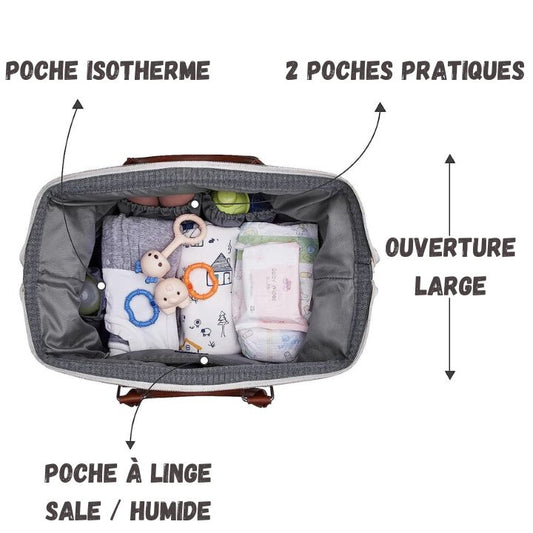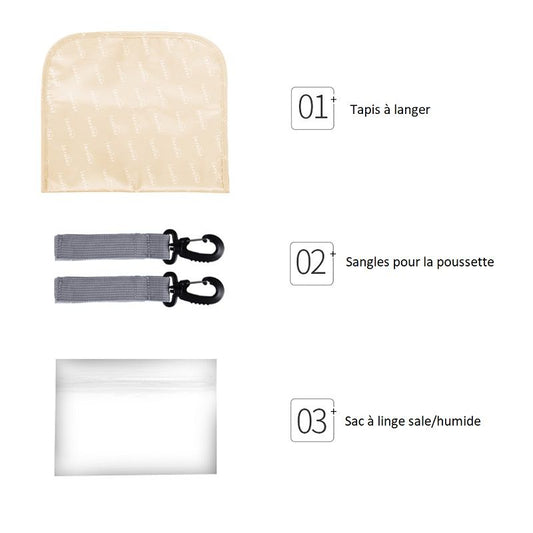Managing Fever in Children
Fever in children over three months old
For children over three months old, fever is usually not an emergency . Small children with viral illnesses tend to develop very high fevers at night. On the other hand, fever is a great defense mechanism that helps children fight off infections more quickly. Some studies have shown that reducing fever with medication can prolong viral illnesses. Since fevers are not dangerous for children, parents should not feel compelled to treat fevers with medications such as acetaminophen (Tylenol) or ibuprofen (Advil/Motrin). For better or worse, these medications are quick fixes that make children feel better, prompting them to return to normal activities when they should be resting.
Discover our Angel Nest collection.
It is important to note that the response of fever to treatment does not reflect the severity of the illness . Parents often panic when they administer medication and the temperature continues to rise; but sometimes it is not possible to bring down a high fever, especially at night. Allowing a child to sleep while the fever resolves on its own may be the best (and only) solution. Placing a feverish child in a lukewarm bath is not helpful and will likely make him or her feel cold.
The question I hear most often about fever is:
“When is a fever too high? Is there a threshold at which I should go to the emergency room?”
Even at 41°C , 80% of children still have viruses. So from most pediatricians' perspective, the significance of a fever is relative . The most important question is whether the child has any concerning signs or symptoms (see below). Fever caused by viral illnesses can take three to four days (or sometimes longer) to resolve. When a child is fighting off a virus, it is not uncommon for the temperature to return to normal during the day and then rise again at night. If a fever lasts more than five days, be sure to make an appointment with your pediatrician.
Summary of key points for managing fever in children:
- Fever alone in a child over three months old is usually not an emergency ; fever helps children fight infections more quickly.
- Unless a child is uncomfortable or has a history of febrile seizures, there is no reason to treat a fever . Lowering a fever can prolong the duration of the illness.
- The response of fever to medication has nothing to do with the severity of an infection ; at night it may be impossible to bring down a high fever, especially in small children.
- Most fevers are caused by viral illnesses that do not require treatment.
- The best treatment for a fever is rest and time .
- The severity of a fever is not critical . The associated signs and symptoms determine how quickly a fever should be evaluated (see next section). Since fever alone can cause vomiting, I generally do not worry too much about vomiting in the setting of a fever (unless vomiting is prolonged, associated with other symptoms, or causes dehydration).
Worrying Signs and Symptoms Associated with Fever
In some cases, fever may be associated with worrisome signs and symptoms that warrant immediate emergency room evaluation. These are listed below:
Worrying skin rashes:
Nonblanching rashes (i.e., rashes that do not turn pale when pressed with your finger) associated with fever should be evaluated immediately in the emergency room. In some cases, nonblanching rashes are an indicator of a serious bacterial illness in children. For example, petechiae are small, nonblanching, purpure spots that may be associated with meningococcemia. As meningococcemia progresses, petechiae may develop into purpura , larger, nonblanching, purple lesions.
Diffuse erythroderma , which resembles a sunburn on the chest, abdomen, and back, is another worrisome rash. It sometimes heralds the onset of septic shock, caused by Staphylococcus aureus infections (people with influenza can develop secondary pneumonias from staph, and they sometimes present with a rash).
In the absence of fever, petechiae and erythroderma are less concerning, but they still need to be evaluated promptly. Please call your pediatrician if you experience these types of rashes.
Rashes that are 100% blanching are usually benign. Incidentally, the nails may appear bluish at the onset of the fever, but this is usually nothing to worry about.
Difficulty breathing:
A child's respiratory rate will increase slightly due to fever, but this does not represent true difficulty breathing. When a child is really having trouble breathing, the rib cage may begin to retract or "collapse," due to the use of accessory muscles in the chest wall. A hypoxic child may have a blue tint around the lips. Children in significant respiratory distress may breathe very rapidly, out of proportion to the fever. Anyone with noisy breathing, such as wheezing (an expiratory whistling sound) or stridor (an inspiratory noise), should be evaluated promptly.
Neck stiffness:
Known as meningismus , pain when bending the neck (placing the chin on the chest) is a sign of meningitis. People with meningitis often have photophobia , meaning they are bothered by bright light. This explains why children with meningitis sometimes arrive at the doctor's office wearing sunglasses. Anyone suspected of having meningitis should be evaluated immediately in the emergency room.
Bulging fontanelle:
A baby's fontanelle (soft spot on the skull) is normally flat. While a sunken fontanelle can be a sign of dehydration, a bulging fontanelle is a worrisome sign that may indicate meningitis or hydrocephalus ("water on the brain") in infants.
Abdominal pain:
There are many important organs in the abdomen, pelvis, and retroperitoneum, and all are susceptible to infection. Severe abdominal pain associated with fever may indicate that a child has a kidney infection, appendicitis, or pelvic inflammatory disease, among other serious conditions. Children with a fever who also have severe abdominal pain should be evaluated by a pediatrician promptly.
Severe pain, wherever it is:
It's always a good reason to go to the emergency room.
Extreme lethargy:
Most children with a fever tend to appear tired, but a child who is extremely lethargic, difficult to awaken, or unresponsive requires immediate evaluation.
Fever associated with foul-smelling urine:
This may be a sign of pyelonephritis (kidney infection). In babies under three months old, pyelonephritis is a potentially fatal infection.
Cold and clammy skin:
This may be a sign of poor perfusion, resulting from bacterial sepsis or shock.
Parental intuition:
Something doesn't seem right, and your anxiety is skyrocketing. Parental intuition is a powerful force. It should never be ignored.
Fever in children under three months
Fever in infants under three months of age is considered a medical emergency until proven otherwise . What is the definition of fever, by the way, in this age group? A normal rectal temperature for newborns ranges from 97 to 100.3°F (36.1 to 37.9°C). Fever protocols for young infants are all based on rectal temperatures. If your baby seems warm and you suspect he or she has a fever, the only accurate way to document the temperature is rectally. Therefore, an essential piece of equipment that every new parent should have at home is a digital rectal thermometer, as well as petroleum jelly. Keep in mind that hypothermia is just as concerning as hyperthermia. If your baby's temperature is below 97°F (36.1°C) or 100.4°F (38°C) or above, your next destination should be a pediatric emergency room. Febrile infants (especially those less than 1 month old) usually undergo a thorough evaluation to rule out bacterial sepsis. Tests may include blood tests, urinary catheterization, and a lumbar puncture (a puncture to rule out meningitis).
A few words about febrile convulsions
One of the “extra-special” ways that febrile children between the ages of six months and six years can terrify their parents is by having a seizure . Simple febrile seizures, while frightening to watch, are not dangerous and usually do not warrant a trip to the emergency room. What characterizes a simple non-urgent febrile seizure ?
- The convulsion is generalized (i.e. the child loses consciousness).
- The convulsion lasts less than 15 minutes .
- The convulsion is non-focal (i.e., it involves the entire body).
- Only one convulsion occurred in 24 hours.
- Febrile seizures have occurred in the past, and parents know exactly what is happening.
The good news about simple febrile seizures is that children usually outgrow them, and they do not increase the risk of developing epilepsy in the future . The bad news is that febrile seizures have a 30% chance of recurrence. Most parents of children with a history of febrile seizures use Motrin and Tylenol liberally during times of illness; because seizures are frightening to watch, treating children aggressively with medication in this situation is not unreasonable. It is important to note that the rate of increase in fever is responsible for the occurrence of febrile seizures. Children who are prone to febrile seizures may therefore convulse at relatively low temperatures.
If your child has a febrile seizure for the first time, you should take him or her to the pediatrician or emergency room for evaluation. The following situations also warrant immediate evaluation for febrile seizures:
- Your child has a stiff neck (the neck hurts when the chin is tilted toward the chest).
- Your child is exhibiting concerning neurological signs/symptoms (vomiting, pupillary changes, lethargy, confusion, etc.).
- Your child is less than one year old .
- More than one seizure occurred in less than 24 hours.
- Your child had a partial seizure (was conscious during the event).
- The seizure was focal (only one part of your child's body was shaking).
- The seizure lasted more than 15 minutes . If a seizure does not seem to resolve within a few minutes, call 911 for help.
To learn more about fever in children and what to do, visit ameli.fr .
























































